Finishing the house from the outside: types of finishing materials, their advantages and disadvantages
When erecting the walls of a house, external facade decoration may be required. Such a need arises when second-rate building materials are used, the facade loses its attractiveness or masking of eliminated cracks is required. But the exterior of the building speaks of respectability and status of the owners. Do you agree?
We will talk about how and using what materials the decoration of the house is done outside. We will show you that it is better to choose and how to install the cladding so that it is durable, beautiful, reliable. Given our advice, you can forget about the repair of the facade for many decades.
The content of the article:
Basic rules for exterior decoration
To maintain normal humidity indicators in the room, the casing should have high steam removal rates.
The building material of which the wall is made should be less vapor permeable than thermal insulation layer, which, in turn, is less vapor susceptible than the material for external wall cladding.
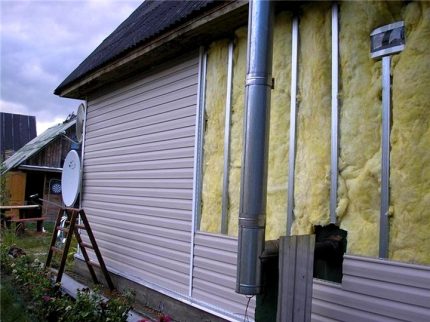
If the characteristics of the materials do not have the required vapor permeability, condensate will accumulate at the boundaries of the layers, creating favorable conditions for the growth of mold, fungi, rotting surfaces.
With a decrease in temperature, sedimentary moisture will freeze, which will lead to the destruction of the wall and finish. After several years, the facade will have to be changed.
Before deciding how to decorate the walls of the house from the outside, you need to familiarize yourself with the technical characteristics of the materials. Although it is already clear that all facing panels and sheets, except for wood, have a low vapor recovery index.
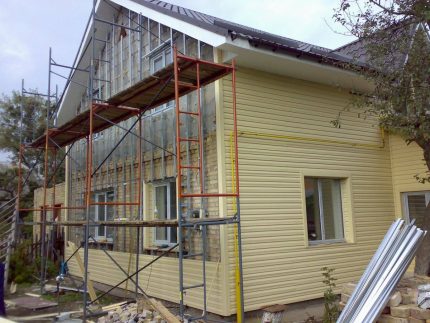
In the case of choosing a cladding made of artificial materials with low vapor permeability, it is necessary to provide for such a facade design in which vapor recovery will occur in a different way.
The problem can be solved in two ways:
- Mount a ventilated facade. To do this, a vapor-permeable thermal insulation and ventilated gaps are placed between the wall and the finishing material, based on: on each segment of the wall with an area of 20 square meters, including windows and doors, there is a gap with a useful volume of 75 square meters. cm.
- Coat the inside of the wall with a vapor barrier. In this case, the cladding can be mounted on the wall of the house, without an adjacent insulation layer. Due to the vapor barrier coating, moisture does not protrude on the surface of the wall and the finishing material, the structure remains dry, therefore, the material for cladding can be chosen without regard to vapor permeability.
In the first embodiment, the upper part of the holes remains open to vaporize. The facade in this case performs a protective and decorative function.
With the advent of expanded polystyrene, the second method of wall cladding began to be used more often. Extruded Styrofoam It has low vapor permeability, it is an effective heat insulator, which allows saving on space heating.
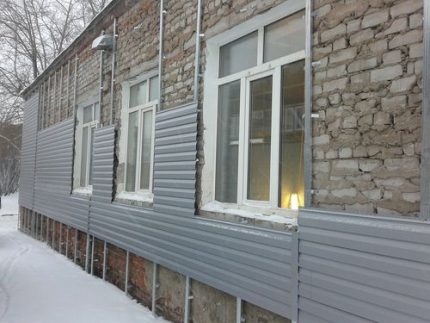
When decorating walls from the inside, any facing material can be mounted on the facade, from wood panels to porcelain tiles.
Siding for house cladding
The most democratic option for home decoration is siding. Material has a lower cost than wood, lumber, ceramics, has a long service life, so it is used much more often than other facade coatings.
Siding can cover walls erected from any material with any option of external insulation. The facade, equipped in this way, is ventilated, since the materials are mounted on the prepared crate, so this coating is universal.
Option number 1 - vinyl panels
Vinyl siding is made from high-tech polyvinyl chloride, which is used in various climatic zones. It is easy to cut, to form the correct facade of houses with uneven walls, ledges, many decorative elements.
The material is a flat strip with a thickness of 10-12 mm, a width of 205-255 mm. The siding is attached to the facade using a perforation line for fasteners and docking locks connecting the two panels to each other.
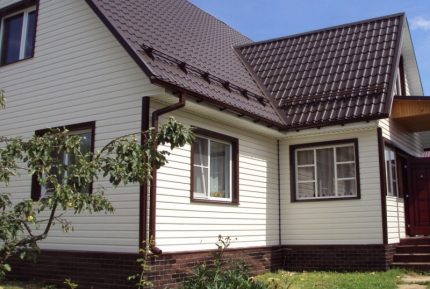
Installation of vinyl strips is carried out on a metal or impregnated wooden crate, consisting of starting and side additional beams. Screws are screwed so that there is a backlash, for possible changes in siding, under the influence of temperatures.
A variation of vinyl panels is basement siding. Only in this case, the panels do not look like stripes, but as a square or rectangular part of the wall.
The material has a greater thickness than vinyl panels, as it is designed to protect the roof base from rain and other influences. But because of its practicality, durability has become widespread when facing facades.
The basement facade is attached to the crate, which is attached more tightly, due to the fact that the panels look like a square, a rectangle of shorter length.

For mounting panels on each there is a perforation and connection lock.When screwing in the screws, play should be left to compensate for possible movements of the material.
Basement siding imitates natural materials better than others. Therefore, with skillful installation, it is possible to distinguish an artificial facade from a wall of stone, brick only by directly touching the wall.
The advantages of vinyl siding are:
- Easy installation on buildings of any configuration.
- Reasonable price of material.
- Installation of a facade made of vinyl siding is possible at temperatures from -5 to +40 ° C.
The disadvantages include quick burnout on the sunny side of the building, so it is better to choose light shades of the panels. In addition, installation at low temperatures from -5 ° C will increase the number of scraps, as the siding will burst with slight bends during processing.
Option number 2 - metal siding
Metal siding is made of aluminum or galvanized steel. A coloring substance is applied to the surface, which performs a protective function.
Material is decorated in two ways:
- It is covered with a polymer shell. Such panels do not fade, are resistant to mechanical stress. During polymerization, manufacturers use a limited number of shades.
- Powder coated. With this treatment, the paint does not fade, it is used for a long time at any temperature without signs of peeling. The panels have a variety of colors and shades.
The installation of metal panels is carried out on the supporting and additional side beams using self-tapping screws and connecting locks on the strips.

The advantages of such panels include their low price, persistent coloring without fading colors on the sunny side of the building. In addition, it is easy to work with metal panels at any time of the year, they bend perfectly, do not break, and are suitable for facing rounded structures.
The disadvantage is the aesthetic simplicity of metal strips. With unsuccessful installation, the building is more like a production hall.
Fiber cement panels for decoration
Fiber cement boards and siding for external cladding are composed of wood fiber, cement, layered mica, quartz. In production workshops, in the manufacture of panels, chlorine and asbestos are added to the solution, therefore, such products can only be used for exterior wall decoration.
From this mixture sheets, strips of various sizes are formed. After that, the panels are dehydrated, through several technological processes, fired and coated with a protective and decorative composition.
The composition may be:
- acrylic - fading time of 8-10 years;
- hydrophilic ceramic - the term of fading is 30 years;
- photocerim - fading time 10-15 years.
With photoceramic spraying, the panels are easy to clean from dirt. The price of such panels is affordable, and the significant size of each panel allows you to save time when arranging even a large building. Therefore, when deciding on how to quickly sheathe a large house outside, pay attention to fiber cement panels or slabs.
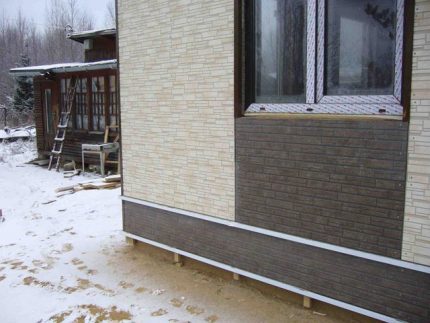
Monolithic plates are mounted on guide rails using clamps. When installing fiber cement siding, the panels are lapped.
Fiber cement facade slabs are strong and durable. For molding, natural eco-friendly materials are used that are not subject to burning, therefore the structure sheathed with fiber cement sheets is considered to be refractory.
A wide variety of patterns and textures, the ability to install glossy or matte boards, allows homeowners to be creative when facing the facade of the house.
In case of violation of the production technology, the plates can have a significant degree of steam penetration, then to eliminate the problem, it will be necessary to install additional waterproofing and varnish the front coating.
Wooden cladding materials
Wood is the only material with good vapor permeability. Wooden products can be mounted on the wall of any material, but they work best in upholstery of a wooden house. Use of any heat-insulating material is allowed.
Natural moisture loss will not allow fumes and condensation to accumulate on the surfaces of wood, the wall will always be dry, which will prevent its destruction. However, direct contact of wall materials with lumber lining should be excluded. Between them must be maintained ventilation gap.
Wooden products for exterior decoration include:
- Block house. A building from a block house looks like a house built of logs.
- Imitation of a bar. In this case, the material imitates a planed beam.
- Lining. More affordable wooden material for cladding the facade of the house.
- Dies, shingles, spindles and planken. Small boards made of wood, suitable for ennobling the facade of the building to the hardworking owner.
Installation of wooden cladding is done on the crate. In the intervals between the beams, basalt cotton wool is laid, after which the wooden paneling is attached.
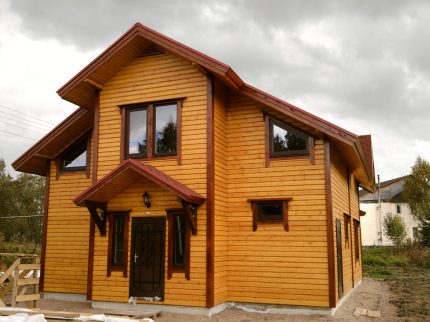
The advantages of wooden cladding include its environmental friendliness, excellent heat and sound insulation. The walls of the building, under wooden sheathing, are protected from mechanical influences, precipitation and temperature changes.
The disadvantages include combustibility and the presence of natural defects, due to which many residues are formed during the initial and subsequent processing.
With proper annual maintenance of the wood, the facade will last for many years. But if there is no possibility and desire to arrange constant surface treatment, use other materials, since wood in its natural state is susceptible to decay, pests and darkening.
Natural and artificial stone finish
The beauty of the facade for many years will provide natural and artificial stone. Materials for wall cladding are made in the form of plates with a smooth, rough and texture coating.
Front slabs made of natural stone formed by processing the following materials:
- marble;
- granite and syenite;
- limestone and sandstone;
- slate;
- dolomite;
- quartzite;
- gabbro;
- labradorite;
- purple;
- breccias.
Fake diamond produced by molding a mixture of cement, sand and stone chips of various fractions. For crushing, expanded clay, ceramic chips, natural pumice and expanded perlite are used.
In the manufacture of artificial stone slabs, finished products at first glance do not differ from natural ones, but they have less weight. In addition, the collection of facade coverings made of artificial stone has absolutely fantastic colors, shades and textures.
For facing the facade with stone panels, it must be prepared so that the maximum surface roughness does not exceed 2 cm. After preparing and cleaning the wall, a reinforcing mesh is fixed. Next, the tiles are laid on the facade, using cement mortar.
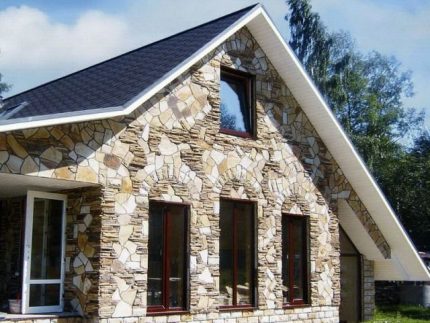
In the manufacture of artificial slabs, natural stone chips, high-grade cement and clean sand are used.
Therefore, the material created in an industrial environment, and natural rocks have the same advantages, which include:
- Strength, resistance to any deformation.
- Durabilityresistance to fading.
- Durability to temperature changes and precipitation.
The main disadvantage of facade stone is its high price. The most expensive materials are granite and marble, the most affordable are sandstone, limestone and artificial analogues of natural stone slabs.
Facade of a house made of tiles
Facade materials for wall decoration are used everywhere, as this is an excellent opportunity to protect the supporting walls of the building from moisture, temperature fluctuations, precipitation, pollution, mechanical stress.
Therefore, manufacturers of building materials have developed cladding panels that have a low price and good performance.
So, for facing facades use:
- gypsum decorative tile;
- clinker tiles made of refractory, shale clay;
- terracotta tiles from unpainted kaolin clay (ceramic);
- porcelain tiles.
Porcelain panels are large and significant in weight, so they are mounted on beams with the help of clamps. Clay and gypsum panels are mounted on the wall of the house with cement mortar, followed by grouting.

In the manufacture of facing slabs from minerals and crushed rocks, the materials go through the crimping and firing stages, therefore these facade coatings:
- have increased strength;
- safe for people, as they are made of natural materials;
- have a small weight;
- Do not lose their original appearance and color;
- have a wide range of shades and textures.
During the firing process, cladding plates completely lose their elasticity and break even when the slightest deformation occurs, especially in the winter season. Therefore, all work with these materials should be rescheduled for the summer.
Facade plaster for exterior cladding
Facade plaster for facing buildings has a different composition, texture and a bonding element. Components for plastering are selected depending on climatic conditions, precipitation frequency and type of primer.

The application of plaster on the base, which tends to expand / contract when the humidity level changes, requires taking measures against cracking on the finish. Therefore, a plastic binder is added to the solution.
In this regard, in the process of preparing the components for the solution, it is necessary to familiarize yourself with the characteristics of the finish and the climatic conditions of the region. Then properly selected plaster will last several decades.
In addition, facade plaster when facing the house has the following advantages:
- protects walls from precipitation and mechanical stress;
- gives the building a unique look, as it can be applied in the form of decorative textures of various colors;
- has high adhesion, elasticity and safe composition;
- resistant to UV rays, temperature extremes.
The high-quality composition applied to the walls of the building has a lot of advantages. But if in the process of mixing the proportions of raw materials were not observed or second-rate materials were used, then the plaster in the first season will partially leave the wall, will crumble and it will be necessary to renew the building’s facade again.
If you decided to insulate the house before performing the facade cladding, pay attention to the technological and practically waterproof Penoplex. The article recommended by us will familiarize with its characteristics, varieties and advantages of use.
Conclusions and useful video on the topic
The cheapest option for covering a country house:
Informative video about the installation of facade panels, analysis of nuances and trifles:
Subject to the technology of facing works, the subsequent proper care of the materials, the building's facade will be used for at least a dozen years. Therefore, before deciding what is better to sheathe a residential building, analyze the advantages and disadvantages of each type of finishing material.
Do you want to talk about how you selected material for decorating the facade of your own house or cottage? Do you have your own opinion and strong arguments justifying your choice personally? Please write comments in the block below, ask questions and post a photo on the topic of the article.

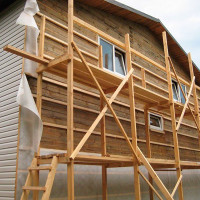 How to sheathe a wooden house outside: the best types of materials and technologies for their installation
How to sheathe a wooden house outside: the best types of materials and technologies for their installation 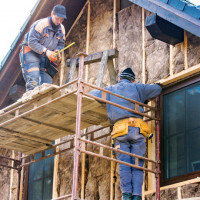 Insulation of a private house outside: popular technologies + material overview
Insulation of a private house outside: popular technologies + material overview 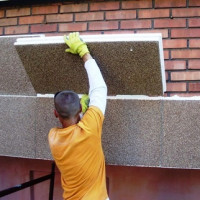 Insulation for walls of the house outside: an overview of options + tips for choosing an external insulation
Insulation for walls of the house outside: an overview of options + tips for choosing an external insulation 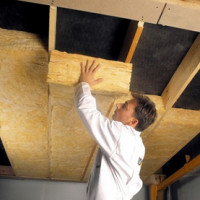 Insulation for the ceiling in a private house: types of materials used + how to choose the right
Insulation for the ceiling in a private house: types of materials used + how to choose the right 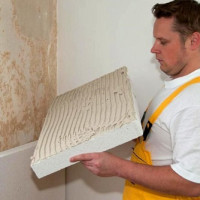 Types of insulation for the walls of the house from the inside: materials for insulation and their characteristics
Types of insulation for the walls of the house from the inside: materials for insulation and their characteristics 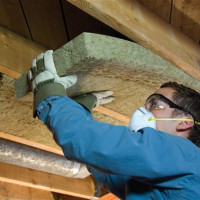 Insulation of the ceiling in a private wooden house inside and out: choosing the best material and the nuances of installation
Insulation of the ceiling in a private wooden house inside and out: choosing the best material and the nuances of installation  How much does it cost to connect gas to a private house: the price of organizing gas supply
How much does it cost to connect gas to a private house: the price of organizing gas supply  The best washing machines with dryer: model rating and customer tips
The best washing machines with dryer: model rating and customer tips  What is the color temperature of light and the nuances of choosing the temperature of the lamps to suit your needs
What is the color temperature of light and the nuances of choosing the temperature of the lamps to suit your needs  Replacement of a geyser in an apartment: replacement paperwork + basic norms and requirements
Replacement of a geyser in an apartment: replacement paperwork + basic norms and requirements
Yes, metal siding is not enough colors, but in addition to this, he has a lot of shortcomings. In the summer, it quickly heats up in the sun, in the heat it does not come up to the walls, and in winter, if you do not pre-heat the house, then no pipes will help to warm up properly. It is better to finish the PVC panels. If you want to protect the house from fire, then you should buy vinyl panels with the marking G1. These do not burn, but smolder slowly.
Almost everyone I know and who finished their house or cottage outside has siding. The reason is simple - the price. But, frankly, these houses, especially when they go in a row, one after another, like metal cars. This makes me feel. Therefore, I decided to dig up my house and saved up for decoration with a stone. Artificial, though (also due to cost), but the appearance of such walls pleases me much more. By the way, I want to say that if you are going to decorate the walls with stone, then they should have the most fresh plaster, no last year’s or even six months ago options. The plaster will fall off - you will redo the entire finish. Flies a pretty penny. Do not rely on just one grid - this is not enough.
Siding decoration is popular not only because of its low cost. Plastic siding is very durable - once I finished and forgot.